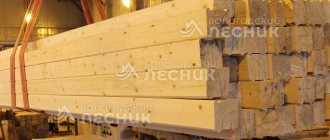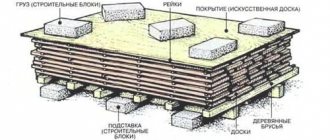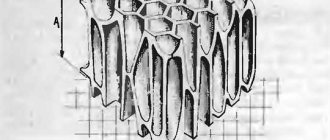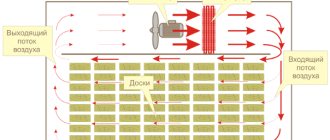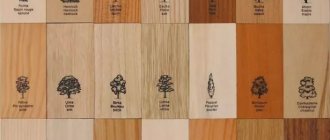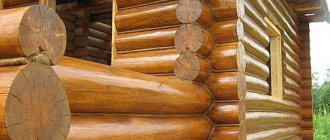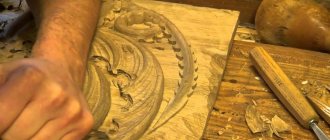Having decided to build a residential building or bathhouse using wooden beams, you need to learn in more detail not only about its advantages and types. The quality of the final result will also depend on the basic characteristics of the material and its weight. Since this building material can be made in various sizes, the weight of its individual elements varies significantly. So how much does a cube of 100x100x6000 timber and other sized products weigh?
Timber for home
How much can a beam weigh and how to calculate it correctly?
The term “beam weight” has two meanings, volumetric and specific.
The most interesting thing in construction is specific. Knowing how much 1 m3 and one unit of such lumber weighs, you can qualitatively develop a project. Since these values are the basis of the loads that are necessary to calculate the foundation of the house. This parameter is also important for the accurate purchase of wooden beams before carrying out construction and installation work and the selection of equipment sufficient for loading and unloading at the construction site.
What does the concept mean?
Before starting to build a house from timber, the developer must clearly understand that there are no two absolutely equal timber in weight, even if they have the same dimensions. Therefore, this indicator is always taken with averaging .
Volumetric weight is determined by the geometric dimensions of the material, when the weight of one unit is multiplied by the amount of bursa in 1 m3. And specific, as the mass of 1 m3 of timber, obtained on the scales.
The specific gravity of raw timber, which was processed from recently cut wood, is in the range of 840 - 860 kg and depends on many quantities.
Article on the topic: Why is it better to build a house made of timber in winter?
What does it depend on?
It mainly depends on the following values: geometric dimensions, grade class, type of tree and its moisture level. The first indicator determines the volume of the product using the formula: cross-sectional dimensions (a * b) and length (L).
According to the grade, GOST 8486 distinguishes 4 classes of timber. The first, the highest quality, is used at critical stages, for example, for the construction of load-bearing walls, the last low-quality - for rough work, for example, when laying a rough foundation under the floor.
The moisture content of the timber depends on the duration of storage, drying parameters and placement conditions.
- dry from 10 to 18%, material that has been technologically dried or stored in a warm, dry building for a long period;
- air-dry with a humidity of 19 to 23% - these are products that have equilibrium humidity, when it is balanced inside the material and in the environment by natural conditions, and no drying technologies were used;
- raw with a moisture content of 24 to 45% - this is sawn wood into timber in the process of transition from a freshly cut wet state to an equilibrium state.
Important! With an increase in the moisture level of the timber, its density increases, for example, the density of pine timber at a humidity of 30% reaches 560 (kg/m3), and at a humidity of 60% - 680 (kg/m3).
What happens?
It depends on the geometric dimensions and type of wood. In order to calculate weight, use the formula: weight in kg equals volume in m3 multiplied by density in kg/m3.
The weight of a 6 m long beam, depending on its cross-section and the type of source wood:
- 40x75 mm : for pine with a density of 520 kg/m3 - 0.04x0.075x6x520 = 9.36 kg, for oak with a density of 720 kg/m3 - 12.95 kg is used for the manufacture of floors, lathing and frames.
- 50x75 mm : for pine with a density of 520 kg/m3 - 0.05x0.075x6x520 = 11.7 kg, for oak with a density of 720 kg/m3 - 16.2 kg and is considered one of the most popular products on the lumber market.
- 100x100 mm : for pine with a density of 520 kg/m3 - 0.1x0.15x6x520 = 31.2 kg, for oak with a density of 720 kg/m3 - 43.2 kg, used for the manufacture of non-load-bearing walls of houses, mainly pine.
- 100x150 mm : for pine with a density of 520 kg/m3 - 0.1x0.15x6x520 = 46.8 kg, for oak with a density of 720 kg/m3 - 64.8 kg, used for the manufacture of internal load-bearing walls of a house, mainly pine.
- 150x150 mm : for pine with a density of 520 kg/m3 - 0.15x0.15x6x520 = 46.8 kg, for oak with a density of 720 kg/m3 - 64.8 kg, used for the manufacture of external load-bearing walls, mainly of pine, and for summer cottages, if the building is located in a high humidity area, then larch timber is used.
- 200x200 mm for pine with a density of 520 kg/m3 - 0.2x0.2x6x520 = 124.8 kg, for oak with a density of 720 kg/m3 - 172.8 kg, used for the manufacture of external load-bearing walls mainly from pine and larch for year-round houses, in the southern regions For such walls, thermal insulation may not be used.
Article on the topic: How long does it take to shrink a house made of timber?
Important! 200 mm timber is widely used in construction work in the formation of beams and trusses, as well as other high-strength fencing systems.
Types of material: what to choose for construction?
Such building material can be presented in various variations:
- Non-profiled material is the most common type. It is presented in the form of a log processed into four edges. However, houses made from this type of log experience significant shrinkage and require additional caulking.
- The profiled material has strict geometric shapes. This option is easier to use, which makes it the most popular.
- Glued laminated timber is a fairly new material, which consists of individual wooden elements. This material is characterized by high strength and long service life, since the drying process is much better.
Table
Why do you need to know when building walls?
When starting to build houses from timber, the customer first of all asks the question of how much of this material is needed to build walls, floors, floors and roofing.
Also, having this data, he can correctly calculate what capacity of transport he should hire for transportation and storage of cargo.
However, this knowledge is most important for choosing a foundation. To do this, first of all you will need to know the loads that the walls will create. In total they constitute the largest part of the total load and increase with the growth of floors, ceiling heights and the size of the house in plan.
Advantages and disadvantages of timber 150x150x6000
The market offers lumber with both a flat surface and a semicircular face. In this case, the walls will resemble the shape of a log house.
The main advantages of using timber are:
- ease of transportation and storage (flat geometric dimensions allow compact placement of material, increasing the volume of transportation);
- resistant to cracks and deformations;
- easy installation, no special equipment required;
- reduction of construction time;
- the tight fit of the beams to each other allows you to reduce the heat output through the walls and thereby reduce the cost of heating the room;
- aesthetics (the walls look smooth, neat and attractive).
- high price and deviation from the format of an environmentally friendly material due to the use of various impregnations that prevent the process of rotting (applies to timber with a laminated veneer structure);
- fire hazard. The requirements for the installation of power supply systems are increasing.
Article on the topic: Why does your stomach hurt after a bath?
The advantage of a house made of timber also includes its weight. It is much lighter than those made of concrete and brick. Therefore, the load applied to the foundation will be significantly less. The weight applied to the foundation of a building is the primary characteristic when designing the foundation of any structure. Let's determine how important this is using a simple example, calculating the mass of load-bearing structures (only walls) of a certain object.
Requirements for foundations
It is believed that walls made of timber do not carry a significant load, compared, for example, with stone ones, therefore for such houses they use light pile or strip type foundations.
To choose the right timber for a specific house foundation, you need to know the following data:
- Height of the building;
- total loads on the base and soil;
- soil characteristics;
- building plan.
The soil creates stress on the side wall of the base of the house. Soil heaving determines the increase in load during wet weather and at very low outside temperatures. An increase in the amount of moisture in the ground increases stress on the foundation of a home.
The pile foundation is designed for load-bearing walls made of timber up to 250 mm. Such a foundation is installed for the load-bearing walls of a large house with winter accommodation, located on marshy soils or with a large difference in relief above 0.5 m.
A columnar foundation can be used for the construction of lightweight one-story houses under timber up to 200 mm thick. It is less expensive, and modern building materials make it possible to modernize it. This way you can use concrete blocks.
Article on the topic: How much will a house made of laminated veneer lumber cost?
Such supports are constructed with dimensions of 200x200x400 mm. They are also poured from concrete into formwork or into large-diameter asbestos-cement pipes installed on a sand bed at support points with high loads.
These foundations are preferable for freezing or heaving soils, which is associated with the least settlement under separately located supports and the best redistribution of load. The pillars are located at a distance of 2.0 m from each other with a sand cushion of at least 0.3 m deepened into the soil by 0.5 m.
Strip foundation for timber up to 200 mm for heavy structures of houses up to 3 floors. This design is universal for different types of buildings; they differ only in the depth of the foundation: buried - below the soil freezing level and shallowly buried - at a soil depth of no higher than 0.7 m. This allows you to correctly select the most suitable foundation for sandy or loamy areas.
The tape model is made in the form of a solid rigid frame structure, and it is not so important whether it is made of block material or in the form of a monolith. The minimum width of such a structure for timber walls should be 5 cm greater than their thickness on both sides.
The monolithic strip version with reinforcement is installed under timber over 200 mm for tall, large households, since it has a significant margin of safety. This leads to an increase in the cost of the house, since this foundation option is the most expensive. In addition, the construction period increases; according to the technology, such a foundation should harden and gain standard strength in about 30 days.
To determine the depth of such a foundation, the pressure from the soil exerted on its side is taken into account. At the same time, experts believe that there is no need to excessively deepen the foundation itself.
In the case when the house is very light, for example, a small country house, then its weight is not able to balance large underground loads, and the foundation will be squeezed out of the ground, which in turn will create deformation disturbances in house construction.
Article on the topic: Is it necessary to sheathe a house made of timber with siding?
A prefabricated strip foundation for timber over 200 mm allows the construction of large houses for permanent residence. Such a base is made in the form of a block solid concrete structure. They are placed under load-bearing walls made of timber along the border of the house on a compacted sand cushion.
The blocks are connected to each other with cement. Suitable for all types of soils, with a depth of 50 cm. For small objects, light foundation blocks of 200x200x400 mm with a weight of 32 kg are installed, which can be laid manually.
standard sizes of laminated veneer
Engineered wood is replacing solid wood in some home construction applications.
Laminated Veneer Lumber is the industry standard in the framing of new buildings and is used to replace solid wood beams and joists in remodeling existing buildings. LVL is made using a process similar to plywood: loose wood veneers, usually pine or fir, are dried and then laminated with adhesives and resins under heat and high pressure to create a strong, permanently reliable lumber structure.
Standard sizes
Sizes can vary by manufacturer, but Georgia Pacific says standard LVL thicknesses are 1 3/4 inches and 3.5 inches. Lengths are typically available in 24, 28, 32, 36, 40 and 44 feet with special orders up to 60 feet. Standard depths are 9 1/4, 9 1/2, 11 1/4, 11 7/8, 14, 16 and 18 inches, with others available by special order.
LVL qualities
According to This Old House, laminated veneer lumber creates structural members that "almost never fail when used properly." Its load-bearing capacity is precisely calculated for each use. All LVL grains move in the same direction and this makes it very rigid and stable. Due to its tensile strength, it has the ability to support heavy weight along its entire length without sagging. Its strength also gives it the ability to span long open spaces, eliminating the need for pillars.
Uses for LVL
Laminated Veneer Lumber is most often used as beams and beams in frame buildings. Its tensile strength makes it suitable for door and window headers, stringers, ridge beams, cantilever roof supports and other beams. Intended primarily to provide only a structural function, the LVL surface is typically of poor architectural quality with visible glue lines; however, if necessary, LVL products can be sanded and painted to provide a similar finish to solid painted lumber. LVL can be used anywhere conventional wood is used, but it is most commonly used for flanges in timber I-beams and laminated box beams. Structural LVL can be used as structural beams - floor and load-bearing members, wall supports, lintel beams and framing beams roofs.
Preserving Trees
According to This Old House, an additional benefit of laminated veneer lumber is that many trees are protected from lumber production because it takes less to make large quantities of veneer lumber than whole lumber.
,
How to calculate how much 1 piece weighs. and M3?
In order to calculate the actual weight of a beam, you will need to measure its length; if it is uneven in cross-section, then it is determined by the shorter distance from the extreme ends, and the width is set anywhere, starting from 15 cm from the edge.
The commercial volume of burse is determined in m3 based on the parameters established by GOST 5306, published in 1983.
The volume of a beam is equal to its width multiplied by its height (axb) and length (L). The weight of the timber is equal to the volume multiplied by the density of the dry wood type.
For example, for a beam 100x140 mm and 6 m long from different species with a wood moisture content of 15%, the weight will be equal to:
- Pine with a density of 510 kg/m3 - 0.1x0.15x6x510 = 45.9 kg
- oak with a density of 700 kg/m3 - 0.1x0.15x6x700= 63 kg
- spruce with a density of 450 kg/m3 - 0.1x0.15x6x450= 40.5 kg
Vegetable garden-365
- home
- SUMMER CALENDAR
- _CALENDARS
- HOUSEKEEPING AFFAIRS
- _PLANTING AND PLANTING MATERIAL
- _
- _
- _HEALTHY RECIPES
- _HELPFUL TIPS
- _ACTIVITIES AND EVENTS
- _
- _DISEASES AND PESTS
- _
- _COUNTRY DESIGN
- _LANDSCAPE DESIGN
- _
- _
- _
- _HOME CONSTRUCTION
- __Foundation
- FLOWERS AND PLANTS
- _FLORAL
- _
- _
- _
- GARDEN
- _BERRIES
- _PUMPKIN
- _TOMATO
- _SPICY
- _NIGHTLANDS
- _VEGETABLES
- _BULB
- _
- _LEAF
- _ROOTS
- _TUBE FRUIT
- _CABBAGE
- _CEREALS
- _
- _TREES AND SHRUBS
- _
- _CHERRY AND CHERRY
- _LEGUMES
- Mega Menu
Glued laminated timber is a planed, dried timber coated with an adhesive base that prevents water from penetrating into the wood fibers, causing it to swell. The volume of laminated veneer lumber – in terms of weight – is slightly different from conventional planed timber.
Consequences of incorrect definition
If the customer incorrectly determines the size of the beam, which becomes known before the construction of the foundation begins, then he can lose money only on transport services, unnecessarily ordering transport several times.
If an error is discovered after the foundation has been erected, then you can change the thickness of the walls within the permissible limits in order to reduce the load on the foundation, for example:
- The initial crown of the box is made of timber of a larger cross-section.
- Subsequent crowns are made of material of less thickness.
- Reduce the partitions inside the house to an acceptable size.
Article on the topic: How to make a bed frame from timber
If the error is not corrected and a house with increased wall weight is erected, this will, sooner or later, lead to its destruction. In order to prevent this, the developer must adhere to the following rules before starting construction:
- Perform an error-free calculation of the load-bearing capacity of the foundation, taking into account the operational weight of the timber structure, maintaining the dimensions when pouring the foundation, according to the established design.
- Purchase quality timber for wall construction. It must be made according to standard technology and not be damaged during storage and transportation.
- Prepare a house project with foundation calculations.
- Invite professional builders to do the work.
- Buy quality fasteners.
- Check the quality of timber processing for fire resistance and biostability using the certificate.
Profiled products
Basic lock profiles.
In addition to smooth products, manufacturers also produce an analogue with a longitudinal locking connection. In this case, the profile geometry may be different.
There are two basic profile connections of wooden beams: Swedish and Finnish. They served as the basis for the invention of dozens of intermediate conjugations: “comb”, “double”, “triple”, etc.
How much does a cube of pine weigh - how does humidity affect it?
The same pine tree can have different weights. This is directly related to the amount of moisture in it. Depending on the percentage of water in wood, dry, air-dry, wet and wet species are distinguished.
- Pine whose humidity is from 10 to 18% is called dry and the weight of one cubic meter is 505-510 kilograms.
- If the humidity is 19-23% , then the mass of one cube is 520 kg.
- At 24-45%, the pine is considered raw and its weight will be about 550 kilograms.
- All wood whose moisture content exceeds 45% is called raw; its cubic meter weighs from 550 to 730 kilograms.
- A cube of freshly cut pine can sometimes reach up to 820 kg, since its humidity exceeds 90% .
More specific information can be found using special tables that show the correspondence between the percentage of humidity and the mass of a pine cube.
Practical approaches and techniques
Often information about lumber is used in a specific form. For example, due to the complexity of measuring the characteristics of untreated wood, round timber and unedged boards, as well as for universal comparison of different species, the following indicators are used:
- volumetric weight, which essentially corresponds to density;
- specific gravity, showing the ratio of the mass of a cube of wood to a cube of water;
- void ratios during storage;
- reference examples.
Article on the topic: How to create a house project from OSB timber
The first indicator is used most often. The weight of a cube of wood is usually calculated based on the fixed density that a given species has at a known level of its humidity, as described above. This is the standard and most common approach. Thus, at 20% humidity, the volumetric weight of a cube of Scots pine is 450 kg/m³ (0.45 g/cm³), oriental oak is 730 kg/m³ (0.14 g/cm³), and so on.
Specific gravity is a ratio that applies to both actual cubic capacity and stockpiled wood that has voids. This indicator is convenient for carriers to use for transportation. It also refers to the ratio of the volumetric weight of a particular wood to the volumetric weight of water. Since the volumetric weight of water is 1000 kg, specific gravity is not only a useful tool for comparing the density of different species, but also indicates whether a given wood will sink or not. If the specific gravity of a cube of eastern oak at 20% is 730 kg, this means that it floats quite well, and iron birch at a humidity of 20% and above (1000-1020 kg) will sink.
The void ratio is used for storage. The volume of untreated wood, including freshly cut wood, is difficult to calculate, so the actual volume is calculated from the number of cubic meters multiplied by the void ratio. For example, if during storage only 80% of the space is occupied by wood, then this coefficient is 0.8, and from 20 storage meters you will get 20 * 0.8 = 16 cubic meters of wood.
Standards are used to compare the actual parameters of wood with the declared ones. This is how, for example, sellers are checked for honesty or the quality of wood.
The convenience and clarity of the indicators used in practice in calculations help to correctly and fully provide construction with supplies, as well as deliver them to the place of use. Therefore, knowledge of the basic properties of building materials is the key to timely and waste-free construction of buildings.
Article on the topic: What is a log house for a bathhouse made of?
How much does a cube of pine weigh - wood density
The weight of wood also directly depends on its density. Density, in turn, is directly proportional to the moisture content of the wood. Dry pine has a density of 0.50-0.52 g/cm 3, and its cubic meter weighs approximately 515 kilograms .
Article on the topic: Which type of lumber is called timber
Completely dried pine wood with a density of 0.48 g/cm 3 has a weight of 480 kg, if the wood is raw, then the density is 0.64-0.85 g/cm 3, 600 - 700 kg per cubic meter.
In general, the higher the moisture content of the rock, the higher its density, and, accordingly, the greater the mass of one cubic meter of wood.
Information about the exact weight of pine (pine lumber) can be useful when transporting it and choosing the carrying capacity of a vehicle.
In general, there are two types of wood weight:
- Specific.
- Volume.
The specific gravity is approximately 1540 kg/m3 and is defined as the mass of one cubic meter without taking into account various indicators such as the type of wood, its humidity and density.
The volumetric weight depends on the moisture content of the tree and its species. The unit of measurement for this weight is g/cm3 . It is worth noting that it is customary to calculate it only at normal humidity, namely 15% .
Determine the volumetric weight according to the following formula:
W – wood humidity;
Уw – volumetric shrinkage;
Y – volumetric weight in a completely dried state;
уw – volumetric weight of wood.
There is another concept - conditional volumetric weight . It is defined as the ratio of the weight of a completely dry piece of wood to the weight of the same freshly cut sample. The overall humidity does not matter, so it is more convenient to use. It is calculated using the formula:
Where Y0 is the weight of dry wood, and y is the shrinkage of the rock, shown as a percentage.
You can do all the calculations yourself, or you can turn to special online calculators that will give you the exact answer in a few seconds.
I hope you liked the detailed answer on the topic: How much does a cube of pine weigh ? This article was published in the section - Construction.
Volume measure
First of all, you need to know how to calculate timber in cubes, since it is in them that the volume of purchased lumber is measured. When making calculations, you may need to determine how many elements or squares of building are included in a cubic meter. The final result will depend on the size of the beams.
Amount
To understand how many units of material are in one cubic meter, you need to carry out fairly simple calculations. The quantity of timber in a cube can be determined if all dimensions are fully known.
In our case, calculations are given for elements with dimensions of 200x150x6000 mm.
The volume of the beam is found according to the presented formula.
- At the initial stage, the initial parameters must be converted to meters. Thus, it will be: 0.2 × 0.15 × 6 m;
- Now you need to determine the volume of one element, that is, you need to multiply the presented data: 0.2*0.15*6=0.18 cubic meters;
- It remains to divide one cubic meter by the result of the previous paragraph. The result is the following example: 1/0.18≈5.55 pieces.
Note! Exactly the same principle is used to carry out calculations for elements with a different cross-section and length. As these parameters decrease, the number of units will only increase.
To simplify preliminary calculations, individual developers may find it useful to have a special table of the amount of timber per cube. With its help, you can quickly determine the final result. You just need to look at the main dimensions of the beams.
Article on the topic: How to cover a gazebo with siding
An illustrative example for determining the volume of one element.
| Dimensions | Things |
| 200x200x6000 | 4,16 |
| 200x150x6000 | 5,5 |
| 150x150x6000 | 7,4 |
| 200x100x6000 | 8,3 |
| 150x100x6000 | 11,1 |
| 100x100x6000 | 16,6 |
Attention! If necessary, a special cubed timber calculator can be used, which allows you to make calculations very quickly. It is enough to enter the initial data.
Number of squares
Many people do not know how to calculate the cubic area of a timber, and this is necessary to determine the square footage of the building. After such calculations, it will not be difficult to find out how much material will be required to construct the object.
The procedure should be something like this.
Table with various indicators.
- The first step is to measure the thickness of the main elements. In this example it is 200 mm;
- Now the resulting value from millimeters is converted directly into meters: 0.2 m;
- At the last stage, the cubic unit is divided by the result that was obtained as a result of the second action: 1/0.2 = 5 square meters. m.
Clarification! Thus, from one cubic meter of material you can build 5 square meters of walls. Now even a novice master will be able to understand how to calculate the cubic area of a beam.
Specific gravity of timber, weight of 1 m3 of timber, weight of a cube of timber.
For this article, we will take a pine beam and show on it an example of calculating the specific gravity of a pine beam.
Article on the topic: How to create a house project from timber pdf
We immediately draw your attention to the fact that there are no two absolutely identical timber in weight, even with the same dimensions, we take average values. The specific weight of one cube of timber, just sawn and processed, is about 830 - 860 kg (it is also called green timber) and in the following calculations we will use fresh timber. The weight of the timber greatly depends on the degree of its humidity - here you can see the table weight of wood on the degree of humidity.
For example, the weight of dry pine timber is around 500 kg/m3, and the weight of wet timber is 830 kg/m3.
In the table we show such popular sections as timber weight 100x100 and timber weight 200x200.
Table of specific gravity and density of timber in 1m3 depending on units of measurement
| Material | Specific gravity kg/m3 | Specific gravity t/m3 | Density kg/m3 |
| timber | 860 | 0.86 | 860 |
Table of the specific gravity of timber depending on its size.
| Beam dimensions in mm | Specific weight of one beam in kg |
| 200x200x6000 | 209,7 |
| 200x150x6000 | 156,3 |
| 200x100x6000 | 103,6 |
| 150x100x6000 | 77,47 |
| 100x100x6000 | 51,8 |
Density of timber
Density is the mass of a body per unit volume, in our case it is kg/m3. The density of the timber directly depends on its humidity. The density of 1 m3 of timber if it is freshly sawn and only processed is approximately 830 kg/m3.
We almost always have 100x100x6000 mm timber in stock, but if we really don’t have this timber, which happens very rarely, then it’s not a big loss, we can still cut it, we ourselves produce all the goods that are presented on our website.
Retail price for timber 100x100x6000 - 6100 rubles excluding VAT per 1 m 3
Wholesale price for timber 100x100x6000 - 5900 rubles excluding VAT from 30 m 3
(
the price varies depending on the volume, check with the manager
by phone)
You can buy timber 100x100x6000 mm GOST 8486 in two ways:
Payment is made in two ways:
1. Payment in cash on the territory of the warehouse, we also have a sawmill there, you can see with your own eyes how they are sawed.
2. Cashless.
Beam 100x100x6000mm GOST 8486-86
. The price for one cubic meter is (1 m3), the price for one piece is (pcs.).
| Photo\Section\Length in mm. | Quantity, pcs. in 1 m 3 | Cost 1 piece. in rub. without VAT | Price for 1 m 3 without VAT |
| 100x100x6000mm | 16.6 | 367 rub. | 6100 rub. |
Characteristics of the product 100x100, 6m long GOST 8486
| Produced | In Russia, Moscow region, Ramensky district |
| Wood species | Fur tree, pine tree |
| Sawing of the sides | Four-edged |
| Lumber grade | 1 — 2 |
| Humidity | Natural |
| Lumber thickness | 100.0 (mm) |
| Lumber width | 100.0 (mm) |
| Lumber length | 6000.0 (mm) + 10 (mm) |
| Net section size | 100x100 |
| Machine | Multi-saw longitudinal sawing (band saw) |
| Calibration | No |
| Type of lumber | Edged |
This material is used:
Widely used in low-rise construction:
In frame house construction - for the manufacture of a load-bearing frame of walls, followed by filling with insulation and sheathing (timber, board, chipboard or OSB).
Ancillary construction - in the absence of strict requirements for the thermal insulation capacity of walls, the 100*100 product can act as a self-supporting wall material when constructing buildings no higher than one floor.
Finishing work - for the construction of internal partitions using a frame or solid method.
Utility work - due to its strength and low weight, the material can be used for the manufacture of supports, scaffolding and other rough work.
Compared to many building materials, the advantages of this product are a small amount of time for shrinkage to occur and excellent heat retention in the house. In many cases, buildings do not need external decoration, since they already look very beautiful.
Wood undergoes strict control at all stages of production. All quality standards and manufacturing conditions are observed. We have taken care of the high quality of the material, and you can use it for any purpose you need and be completely confident that it will last for many years. Everything needs care and this material is no exception; after building a structure, it must be treated with antiseptic impregnations or paint and varnish material, thereby creating additional protection from rotting and fungus.
Our company is the manufacturer of these products. Therefore, our prices are quite affordable, and special discount conditions apply for large orders; the larger the volume, the cheaper the cost of the goods. You can find out detailed information from our managers by calling the indicated numbers.
Deception when buying timber with a cross section of 100x100x6000mm. Fraudulent sales scheme, damage in tons. Using simple mathematical operations, I show the damage in tons.
In this article, I will consider only pine material growing in the central part of Russia, since this material is most in demand in the construction market of the city of Moscow. Country wooden houses are built from pine. I’ll immediately make a reservation that pine growing in Siberia has a denser texture, weighs more and costs an order of magnitude more. You can even distinguish it visually. The weight of one cubic meter of freshly sawn and processed pine lumber is about 860 kg
.
Nominal dimensions, weight and quantity of lumber in 1 cubic meter
The sizes of softwood lumber are regulated by state standards and rules GOST 24454-80. This document applies to edged and unedged materials that are produced for the needs of our country and are also sent for export.
Article on the topic: Is it necessary to sheathe a house made of timber with siding?
A good master will never order building materials “by eye.” A correctly drawn up estimate for the construction of a house, bathhouse, gazebo and other objects must include the exact amount of lumber. Not everyone will be able to immediately determine how many boards, 6 meters long, are contained in a cube.
A cubic meter is a standard unit of measurement used by all domestic lumber suppliers. If we talk about length, then in addition to footage, you can come across the term “molding”, but this is relevant for the purchase of piece products.
As a rule, boards are not sold in pieces, so you will have to order the required number of cubes. But we need to cover not cubic meters, but square meters, which means we will need to find out the exact number of boards. So how to determine how many pieces will be in one cube?
Helpful information.
Some people ask a very reasonable question - why are boards produced mainly at 6 meters? It's not a matter of the height of the trees, but purely of logistics. Naturally, during the construction of various objects, non-standard lumber may be needed, for example, 7, 8 meters or more. But you will have to pay significantly extra for the delivery of such products, because they can only be loaded onto a road train. Therefore, 6-meter boards are the most common and affordable.
In the calculations below you can see how many lumber with a nominal section of the most popular length of 6 meters fits in 1 cube. It should be noted that the above GOST allows the production and sale of material having dimensions different from those specified in the regulatory document, and in order to calculate their quantity in 1 cubic meter, you must use a simple formula:
n
– number of boards, beams or beams, pcs;
A
– thickness, m;
b
– width, m;
With
– length, m.
Example
: Let's calculate the number of boards measuring 16x75x6000 mm in 1 m3:
This is a universal formula that is suitable for absolutely any lumber. Thus, the error is reduced to almost zero.
Article on the topic: How much will a house made of laminated veneer lumber cost?
Helpful information.
The sequence of calculations is suitable for absolutely all lumber with flat surfaces. And it doesn’t matter what kind of wood they are made of, the main thing is to know the parameters of each board, beam and lining.
Material characteristics
- Material thickness. This indicator is considered the determining parameter for the degree of thermal conductivity of the entire structure of the house. Based on the climatic zone in which the construction process is taking place, you can select timber with different thicknesses, which will have different weights;
- Strength of the material. Timber belongs to heavy materials, since its average mass exceeds one. Thanks to this, you can quickly carry out all installation work;
- Coefficient of thermal conductivity. How much is it equal? This indicator for pine timber is 0.15 W/(mxK). In practice, this means that the heat inside the house can be retained for more than fifteen hours. The thickness of the material also has a big influence on this. Pine timber is considered the optimal solution for those who want to be cool in the summer and warm in the winter;
- Stability of parameters. Due to proper drying, as well as the optimal moisture content in the wood, the timber does not change in size for many years;
- No tension. If all technologies for cutting the material are followed, the tension inside it is relieved. Thanks to this, the timber holds its shape and is not subject to deformation;
- Naturalness. The wood used is considered a natural material that will not cause any harm to human health;
- Minimum shrinkage. Thus, the construction of a house from laminated veneer lumber reaches 3% shrinkage, the construction of a house from profiled timber is 4-5%. Pine timber shows excellent results, since thanks to its qualities, shrinkage will be only 0.8%. Because of this, you don’t have to worry or think about cracks or possible gaps;
- Fire safety. The material always undergoes special treatment with a special composition, after which the timber will not support the combustion process, even if it is under open fire;
- Long service life. This indicator depends on the strength of the material, as well as on the quality of the construction process. Pine wood is strong enough to build a quality structure;
- Aesthetics. The material has a beautiful texture, thanks to which the building will have a beautiful natural color.
All these characteristics make pine timber an excellent material for construction. It is great for many purposes and can also be used to create pieces of furniture. No matter how hard you look, this material is excellent material.
In this article, I will consider only pine material growing in the central part of Russia, since this material is most in demand in the construction market of the city of Moscow. Country wooden houses are built from pine.
I’ll immediately make a reservation that pine growing in Siberia has a denser texture, weighs more and costs an order of magnitude more. You can even distinguish it visually, but this is a topic for a separate article.
The weight of one cubic meter of freshly cut pine and processed into edged lumber is about 860 kg.
Knowing the types of beam sections, you can calculate the weight of 1 piece of timber. The most popular sections of timber during construction:
- 200x200x6000mm. (4.1 pieces in 1m3):
- 860kg. :
4.1pcs. =209.7kg.The weight of one beam with a section of 200x200 is 210 kg.
- 200x150x6000mm (5.5 pieces per 1m3)
- 860kg. :
5.5pcs. = 156.3 kg.The weight of one beam with a section of 200x150 is 156 kg.
- 200x100x6000mm (8.3 pieces per 1m3)
- 860kg. :
8.3pcs. = 103.6 kg.The weight of one beam with a section of 200x100 is 104 kg.
- 150x150x6000mm (7.4 pieces per 1m3)
- 860kg. :
7.4pcs. = 116.2kgThe weight of one beam with a section of 150x150 is 116 kg.
- 150x100x6000mm (11.1 pieces per 1m3)
- 860kg. :
11.1pcs. = 77.47The weight of one beam with a section of 150x100 is 78 kg.
- 100x100x6000mm (16.6 pieces in 1m3)
- 860kg. :
16.6 pcs. = 51.8 kg.The weight of one beam with a section of 100x100 is 52 kg.
- 100x50x6000mm (33.3 pieces in 1m3)
- 860kg. :
33.3pcs. = 25.8 kg.The weight of one beam with a section of 100x50 is 26 kg.
To determine for yourself how much it will weigh, let’s say a beam 4000mm and 3000mm long. I will give an example of a calculation formula in which a necessary condition for the calculation is the number of pieces per 1 m3.
- For timber, let's say 200x200x3000mm:
1
:
0.2
:
0.2
:
3 =
8.3
pcs. in 1m3 - 860kg. :
8.3 pcs. = 103.6 kg.The weight of one beam with a section of 200x200 and a length of 3000 mm. 104kg.
- For timber 200x200x4000mm:
1
:
0.2
:
0.2
:
4 =
6.25
pcs. in 1m3 - 860kg. :
6.25pcs. = 137.6 kg.The weight of one beam with a section of 200x200 and a length of 4000 mm. 138kg.
At the end of the article, I would like to note that these calculations are valid only for timber of clearly stated dimensions with the correct geometry, i.e., corresponding to GOST 8486-86.
For "Armenian timber"
that at 4200 rubles per 1 m3
a separate approach
, because the number of pieces. in 1m3 each time it is necessary to calculate separately in accordance with the dimensions of the timber.
Lumber Tables
Below are detailed data that will immediately allow you to determine the required amount of lumber from 3 to 6 meters in length. It is very easy to use these tables - we find the required product sizes and see the amount of material and the volume of one element.
Helpful information.
Please note that these tables are approximate results. Doing your own calculations is more accurate. In addition, different manufacturers approach the stacking of lumber in their own way, so the density of the products can vary greatly. Therefore, make a reserve of about 10-20%, otherwise you will have to pay for delivery again.
Table 1.
Number of boards in 1 cubic meter of materials.
Table 2.
Amount of timber in 1 cubic meter of materials.
Table 3.
The amount of lining in 1 cubic meter of materials.
Calculations by example
When drawing up an estimate, it is necessary to determine as accurately as possible the volume of the main material, since its price is quite high. If you purchase a large number of elements, a significant part will remain, which will lead to unnecessary expenses. Also, there may not be enough timber, then you will have to order transport again.
In this regard, calculations need to be given special attention. In our situation, all calculations are given for a 6x4 m building with a wooden wall height of 3 m. There is a four-meter partition inside.
During the work, timber 100x100x6000 mm will be used.
Approximate plan of the future structure.
- It is immediately necessary to determine the area of the external walls. To do this, you need to calculate the quadrature of each plane, and then add up the results: (6*3+4*3)*2=60 sq.m;
- The area of the partition must be added to the resulting number. Its quadrature is determined by the same formula. The result should be something like this: 4*3+60=72 sq.m;
- Now you need to understand how many squares of walls can be built using one cubic meter of material. The thickness of the timber is 100 mm, so it turns out: 1/0.1=10 sq.m;
- At the final stage, you can determine the number of cubic meters of material that will be required for the work. The total building area is divided by the result of the previous paragraph: 72/10 = 7.2 cubic meters. m.
Addition! When making calculations, you should take into account the area that window and door openings will occupy. In some situations, their square footage can be quite large.
Weight of softwood lumber
The weight of lumber is a variable quantity. It can vary significantly depending on several factors: the condition of the wood, its humidity, and the stage of processing. This indicator can even be affected by the area of the forest in which the trees were cut down, as well as the part of the trunk from which the boards or beams are made.
Table 4
.
Weight of lumber produced from coniferous and deciduous trees
Average weights are shown here. The actual value can vary between 0.7-1.3 from the average.
Lumber and Wood Products Weights and Measures
Kinds
|
